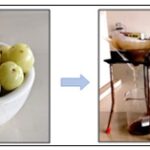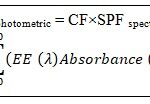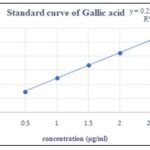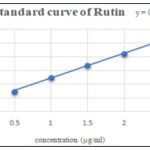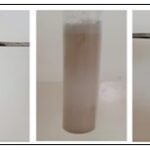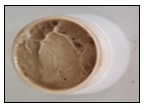DEVELOPMENT AND ASSESSMENT OF SUNSCREEN CREAM USING PHYLLANTHUS EMBLICA EXTRACT AS ACTIVE HERBAL COMPONENT, FOLLOWED BY DETERMINATION OF QUANTITATIVE ANALYSIS
HTML Full TextDEVELOPMENT AND ASSESSMENT OF SUNSCREEN CREAM USING PHYLLANTHUS EMBLICA EXTRACT AS ACTIVE HERBAL COMPONENT, FOLLOWED BY DETERMINATION OF QUANTITATIVE ANALYSIS
Sonam Saini *, Monika Malik and Kartik
G. V. M. College of Pharmacy, Sonipat, Haryana, India.
ABSTRACT: The present study indicates that the development of sunscreen by incorporating natural ingredients obtained from Phyllanthus emblica results in overcoming the side effects of chemically synthetic formulations. The Indian gooseberry, Phyllanthus emblica Linn, is a deciduous tree of the Euphorbiaceae family. The fruit of P. emblica is most widely used herbal drugs in Ayurvedic and Unani systems of medicine. Its chemical constituents include tannin (emblicanin A and B), phenol (gallic acid, ellagic acid), vitamins (ascorbic acid, niacin, thiamine, riboflavin), flavonoids (rutin, quercetin, kaempferol), and alkaloids (phyllantin, phyllembein), among others. Major formulations of Phyllanthus emblica, such as powder, oils, and candy, containing quercetin and emblicanin constituents, show biological potentials including antioxidant, hepatoprotective, anti-inflammatory, and neuroprotective properties, among others. Sunscreens were the best alternatives to prevent sunburns or to protect the skin from the damaging effects of UV rays. The herbal ingredients in the formulation were safe to use as they contain natural substances having fewer side effects, are renewable sources, are under the GRAS (Generally Regarded as Safe) category, and are less expensive. In the present study, the Phyllanthus emblica based herbal sunscreen cream is prepared and evaluated by using different parameters such as preliminary phytochemical screening, organoleptic properties and UV-visible spectrophotometric evaluation. Different herbal ingredients, such as Phyllanthus emblica extract, olive oil, coconut oil, rose oil, vitamin E, etc., were used to formulate the sunscreen cream. The result of this study shows that the total phenolic content present in Phyllanthus emblica was found to be 1.77 µg/ml (µg of gallic acid/mg of extract), and the flavonoid content was found to be 1.96 µg/ml (µg of quercetin/mg of extract). The preliminary phytochemical screening and organoleptic properties of the herbal sunscreen cream were found to be very significant. The sun protection factor (SPF) of the formulation was found to be 11.45, and shows a good photo-protecting product.
Keywords: Sunscreen, Phyllanthus emblica extract, Antioxidant, Anti-inflammatory, UV Spectrophotometer
INTRODUCTION: Sunscreens were the best alternatives to prevent sunburns or to protect the skin from the damaging effects of UV rays. Mainly, Ultraviolet A and B harmful rays are responsible for the skin disorders like photoaging, skin pigmentation, sunburns, and various painful effects 1, 2.
A topical sunscreen formulation known as a photo-protecting agent that protects against this harmful radiation must be created to repair, reduce sunburn, prevent sun tanning, and inhibit skin melanoma, as well as to minimise the appearance of early fine lines and wrinkles, while increasing the degree of sun protection factor (SPF) ranging between 10 and 50+.
The higher the SPF number, the more protection the sunscreen provides against sunburn 3. Sunscreen absorbs, reflects, or scatters some of the UV radiation on the skin from exposure to ultraviolet radiation. Usually, bioactive substances are available that protect the skin from their harmful effects, particularly the lack of dangerous chemical moieties, and in cosmetic formulations have become very popular over the past years 4. Many sunscreen formulations are available in the market, i.e., cream, lotion, gel, ointment, etc. During the market survey, it was found that there are some adverse effects of synthetic sunscreen agents, like cell mutation, DNA damage, hormone alteration, and eczema (allergic reaction). Based on the efficacy of absorption of UV rays, various formulations have multifunctional sun protection activity due to the presence of chemical-based synthetic agents, which directly reflects the high cost of products. Nowadays, to overcome the major effects of synthetic constituents, such as carcinogenicity, toxicity, the herbal ingredients in formulations are preferred due to their natural anti-cancerous, anti-mutagenic, and non-toxic properties 5, 6. Apart from this, the herbal ingredients in sunscreen cause less irritation to the skin and eliminate the use of chemical sunscreen products. The natural herbal components can regenerate the skin and give enough protection against pollution and climate change in the atmosphere. The phenolic and polyphenolic herbal components show antioxidant, antifungal, anti-inflammatory, antiproliferative, etc. activities and are responsible for the absorption of UV rays 6.
In the Indian system of medicine, a well-known Ayurvedic ingredient is Indian gooseberry, having the biological source Emblica officinalis, Phyllanthus emblica, which is a deciduous tree of the Euphorbiaceae family. It is an edible fruit and sour as well as bitter in taste, astringent and quite fibrous with highly nutritional value. It is native to tropical South-Eastern Asia and found in mixed forests of tropical and sub-tropical regions at altitudes of 150-1400 m 7. The taxonomic hierarchy of Phyllanthus emblica is represented in Table 1.
TABLE 1: CLASSIFICATION OF PHYLLANTHUS EMBLICA BASED ON THE TAXONOMIC HIERARCHY
| Kingdom | Plantae |
| Division | Angiospermae |
| Class | Dicotyledonae |
| Order | Malpighiales |
| Family | Euphorbiaceae |
| Genus | Phyllanthus |
| Species | Officinalis |
The major chemical constituents, along with percentage contents present in Phyllanthus emblica, show remarkable properties such as absorbance of a broad spectrum of UV rays, antioxidant, and anti-inflammatory effects, are presented in Table 2. They also cause skin tightening, help to prevent skin damage, acne healing, fading of scars, lighten the dark circles, and effectively make the skin radiant. The herbal products provide self-colouration, so that the artificial colouring agent may be avoided. Creams are of biphasic formulation, i.e. emulsion, either water in oil (w/o) or oil in water (o/w).
TABLE 2: CHEMICAL CONSTITUENTS OF PHYLLANTHUS EMBLICA
| Sr. no. | Chemical Constituents | Compositions |
| 1 | Vitamin C | Ascorbic acid |
| 2 | Flavonoids | Quercetin, rutin |
| 3 | Carbohydrates | Pectin |
| 4 | Amino acids | Glutamic acid, Proline, Alanine, Aspartic acid, Cystine, Lysine |
| 5 | Alkaloids | Phyllantine, Phyllembein, Phyllantidine |
| 6 | Tannins | Emblicanin A, Emblicanin B, Punigluconin, Pedunculagin, Chebulinic acid |
Nutritional Value: According to nutritional qualities, Phyllanthus emblica is well well-known medicinal plant. It is the richest source of vitamin C, polyphenols, minerals and much more 8, 9. The percentage content of major nutrients is shown in Table 3 below. In the present research, the herbal sunscreen cream was prepared using Phyllanthus emblica extract with different suitable ingredients. The organoleptic properties, preliminary phytochemical screening, total phenolic content, total flavonoid content and stability of herbal sunscreen cream were examined. By using a spectrophotometric approach, the sun protection efficiency of the cream was assessed in terms of SPF.
TABLE 3: NUTRITIONAL VALUE OF PHYLLANTHUS EMBLICA FRUIT IN % / PER 100G
| Chemical Components | Percentage |
| Protein | 0.5 |
| Fibre | 3.4 |
| Calcium | 0.05 |
| Phosphorus | 0.02 |
| Fat | 0.1 |
| Iron | 1.2 mg |
| Vitamin C | 600 mg |
| Mineral matter | 0.7 |
| Carbohydrate | 14.1 |
| Nicotinic acid | 0.2 mg |
| Moisture | 81.2 |
MATERIAL AND METHODS: The fruit of Phyllanthus emblica was collected from the herbal garden of BM College of Pharmacy, Gurugram, India and other ingredients such as olive oil, coconut oil, vitamin E, etc. were collected from the market.
All the chemicals were brought from Loba Chemie Pvt. Ltd, India and CDH, New Delhi. For the formulation of Phyllanthus emblica based herbal sunscreen cream, the raw materials were used and listed in Table 4.
TABLE 4: LIST OF INGREDIENTS USED FOR THE FORMULATION OF SUNSCREEN
| Sr. no. | Ingredients | Quantity used (%w/w) | Roles |
| 1 | Rose water | 10 | Fragnance |
| 2 | Stearic acid | 8.5 | Thickening agent |
| 3 | Sodium lauryl sulphate | 1 | Emulsifying agent |
| 4 | Cetyl alcohol | 3.5 | Emulsifying agent |
| 5 | Methylparaben | 0.01 | Preservative |
| 6 | Olive oil | 15.59 | Moisturizing agent |
| 7 | Glycerol | 3.78 | Humectant |
| 8 | Starch | 1.5 | UV protection |
| 9 | Extract of Phyllanthus emblica | 5 | Active constituent |
| 10 | Water | q.s | Solvent |
| 11 | Triethanolamine | q.s. | Surface active agent |
Preparation of Phyllanthus emblica Extracts: The fresh fruit of Phyllanthus emblica was washed using tap water to clean the dust particles on it. Then the fruit was chopped and deseeded. The coarse powdered Phyllanthus emblica was collected, followed by a grinding process. The aqueous extract of Phyllanthus emblica powder was collected by occasionally stirring at 60-70°C for 1-2 hours in a water bath through filtration, as shown in Fig. 1, and the ethanolic (hydroalcoholic) extract was collected by a maceration process (within 3-7 days) using a mixture of ethanol and water with a 70:30 respectively. Then concentrate the extract by gently heating it in a water bath to reduce the volume but avoid overheating. These two extracts were collected and stored at room temperature in amber coloured bottle to protect from light for further use 10.
FIG. 1: PREPARATION OF PHYLLANTHUS EMBLICA EXTRACT
Phytochemical Screening for Phyllanthus emblica extract: The Phyllanthus emblica extracts were subjected to several chemical tests to detect the presence of phytochemical constituents such as flavonoids, saponins, carbohydrates, polyesters, tannins, etc 11-13.
Test for Carbohydrates: The Fehling test was performed to detect the presence of carbohydrate in Phyllanthus emblica by mixing equal amounts of Fehling’s solutions A and B in the extract and boiling it for 10 minutes. The brick-red colour precipitate indicates the presence of carbohydrates.
Test for Saponins: A Foam test was carried out to determine the presence of saponins in the test sample. Mix the extract with 20 ml of distilled water and stir it for 15 minutes. The formation of a 1 cm layer of foam at the top of the liquid showed the presence of saponin.
Test for Flavonoids: The extract was mixed with 1 ml of sodium hydroxide solution to detect the presence of flavonoids in the sample. Its presence indicates yellow colour.
Test for Phytosterols: The Salkowski test was done for phytosterols. In this test, the concentrated sulphuric acid was added from the side of the test tube to the chloroform extract. A reddish-brown colour in the chloroform layer.
Test for Phenolic Compound & Tannin: In this test, the ferric chloride solution was added drop by drop to the extract. The black coloured precipitate indicates the presence of phenolic compounds and tannin.
Quantitative Analysis of Phyllanthus emblica Extract:
Total Phenolic Content: Using a modified Folin-Ciocalteu calorimetric method, spectrophotometric analysis was employed to determine the total phenolic content 14.
Preparation of Standard Stock Solution: The reagents were diluted with the solvent to yield the standard (gallic acid) curve ranges of 0-100 µg of gallic acid/ml. 1 ml of 10% (v/v) FC reagent was added to the test tubes and incubated for 5 minutes. Then, dissolve 0.8 ml of sodium carbonate of 7.7% (w/v) concentration and make up the final volume to 10 ml with deionised water. After that, the mixture was left to incubate for another hour at room temperature in the dark. By using a Shimadzu UV-3600 plus UV-Vis spectrophotometer, the absorbance was measured at a wavelength of 760 nm and compared with the blank. A calibration graph was designed against concentration vs absorbance.
Sample Preparation: A 1 mg/ml sample was prepared using methanol, and UV spectroscopy was used to compare the absorbance to the blank solution. The quantity of gallic acid in the sample extract was determined by plotting a standard curve for calculation.
Total Flavonoid Content: The flavonoid content was evaluated by a calorimetric method using aluminium chloride (AlCl3) 14.
Preparation of Standard Solution: Test tubes were filled with 1 ml of 5% sodium nitrite. After ten minutes, add 0.32 ml of a 10% AlCl3 solution to it. 2.1 mL of 1M sodium hydroxide was added to the mixture after 5 minutes. Immediately after that, distilled water was added and thoroughly mixed. The absorbance was measured at 510 nm and compared to the blank. For the calibration curve, the rutin was taken as the standard.
Sample Preparation: A 1 mg/ml sample was prepared using methanol, and UV spectroscopy was used to compare the absorbance to the blank solution. The quantity of rutin in the sample extract was determined by plotting a standard graph curve for calculation, and the concentration was expressed as milligrams of rutin equivalents per gram of material (mg/g).
Preparation of Herbal Sunscreen Cream: The biphasic solution, such as oil in water and water in oil, was prepared using raw materials for the preparation of sunscreen. This was done by mixing both phases. The emulsifying agent (cetyl alcohol, sodium lauryl sulfate) and other oil-soluble components were dissolved in the oil phase on a hot water bath to make the oil-in-water (o/w) phase. Now, the preservatives (methyl paraben) and other water-soluble ingredients were dissolved in the aqueous phase in a water bath to prepare the water-in-oil (w/o) phase. Then, both phases were mixed by stirring continuously to obtain a homogeneous product 15, 16. The formulated cream was collected and filled into a container as shown in Fig. 5.
Evaluation Parameters of Phyllanthus emblica Based Sunscreen Cream:
Organoleptic Evaluation of Sunscreen: Firstly, the evaluation of herbal sunscreen cream was done by the organoleptic parameters such as appearance, colour, transparency, smoothness and homogeneity, etc 16-19.
pH Determination: About 1 g of formulated cream was accurately weighed and dissolved in 100 mL of distilled water for 2 hours. To determine the pH of the sunscreen cream, a digital pH meter was used. The main significance of this study was to signify the similar pH of the formulation to the pH of the skin.
Spreadability Test: About 0.5 g of cream was placed in a circular form of 1 cm diameter on a 20×20 cm glass plate, over which the second glass plate was placed. A weight was allowed to rest on the upper glass plate for 5 minutes, and then an increase in the diameter of the cream due to spreading was noted.
S = M × L / T
Where, S-Spreadability, M- Weight tied to the upper slide, L- Length of glass, T- Time
Rancidity: The phloroglucinol solution was used to determine the oxidation of fats and oils (commonly known as rancidity). The free fatty acids react with the phloroglucinol solution, resultingin the development of a pink colour and showing the rancidity of the product.
Test for Homogeneity: By visual appearance and touch, the formulation was evaluated.
Test for Irritability: The formulated sunscreen was applied on a 1 sq. cm area of skin for some time, and irritancy was examined and reported.
Determination of Sun Protection Factor (SPF): The efficiency of sunscreen can be examined by calculating the sun protection factor. It is a measurement of the portion of sunburned skin. The SPF values represent the formulation that protects the skin from UV radiation for an interval of time. By using the UV-spectrophotometric method, the sun protection factor was calculated.
In this method, 1 g of cream was weighed. Dissolve it in sufficient volume of 90% ethanol and make up the volume to 10 ml. A Blank solution was also prepared. The absorbance values of each aliquot prepared were determined at 5 nm intervals from 290 nm to 320 nm 20, and the results are mentioned in Table 6. The SPF was calculated by the following equations;
Where, CF = Correction factor 10, EE = Erythrogenic effect of radiation with wavelength (λ), Absorbance (λ) = Spectrophotometric absorbance values at wavelength. The value of EE × I is constant and represented in Table 5.
TABLE 5: VALUE OF EE×I (CONSTANT) AT DIFFERENT WAVELENGTHS
| Wavelength (nm) | Values |
| 290 | 0.0150 |
| 295 | 0.0817 |
| 300 | 0.2874 |
| 305 | 0.3278 |
| 310 | 0.1864 |
| 315 | 0.0837 |
| 320 | 0.0180 |
| Total | 1 |
RESULTS AND DISCUSSION: The sunscreens infused with Phyllanthus emblica are gaining popularity for their natural antioxidant properties and skin-enhancing benefits, such as protecting skin from UV exposure, skin brightening, improving skin texture, providing hydration, and the main significance is non-sticky finishing. Evaluation of sunscreen was done by various parameters like the preliminary phytochemical tests, organoleptic properties & UV Spectrophotometer analysis.
The results of preliminary phytochemical screening (presented in Fig. 4 of Phyllanthus emblica extract signify the presence of various bioactive compounds, including flavonoids, alkaloids, tannins, saponins, and others that may contribute to the plant’s medicinal or therapeutic properties & ensure quality control of Phyllanthus emblica-based sunscreens.
Determination of Total Phenolic Content: The standard acid shown in the phenolic content of hydroalcoholic Phyllanthus emblica was 1.77 µg/ml (µg of extract). The standard curve of Gallic acid is shown in Fig. 2. The total of Phyllanthus emblica fruit extract was found to be of Gallic acid/mg.
FIG. 2: CALIBRATION CURVE OF GALLIC ACID IN METHANOL
For the determination of total flavonoid content, the standard graph Curve of Rutin is shown in Fig. 4. The total flavonoid content of hydro alcoholic extract of Phyllanthus emblica was found to be 1.96 µg/ml (µg of Rutin/mg of extract).
FIG. 3: CALIBRATION CURVE OF RUTIN IN METHANOL
For the determination of the quality, safety, and usability of a formulated Phyllanthus emblica-based herbal sunscreen, all organoleptic evaluation parameters show good results, as shown in Fig. 4 and represented in Table 6 and can be considered as a good formulation.
FIG. 4: RESULTS OF PRELIMINARY PHYTOCHEMICAL EVALUATION TESTS
TABLE 6: RESULTS OF PHYLLANTHUS EMBLICA BASED HERBAL SUNSCREEN
| Sr. no. | Parameters | Observations | Results |
| 1. | Colour | Light brown | Indicates use of natural ingredients, i.e. Phyllanthus emblica |
| 2. | Texture | Smooth | Desirable for easy application |
| 3. | pH | Neutral | Skin-friendly |
| 4. | Rancidity | No pink colour | The product is stable and not oxidised |
| 5. | Spreadability | Good | Ensures even coverage and better sun protection |
| 6. | Irritation | No | Safe for sensitive skin |
| 7 | Homogeneity | Uniform | No coarse particle visible |
FIG. 5: FORMULATED PHYLLANTHUS EMBLICA BASED SUNSCREEN
Results of Sun Protection Factor: The SPF of the sunscreen determines the effectiveness of the product in reference to ultraviolet radiation. The higher the SPF, the greater the tendency of the sunscreen to absorb, reflect the ultraviolet rays and protect the skin from their effects.
TABLE 7: ABSORBANCE OF FORMULATED SUNSCREEN AT DIFFERENT WAVELENGTH
| Wavelength (nm) | Absorbance | SPF |
| 290 | 2.342 | 0.035 |
| 295 | 1.766 | 0.144 |
| 300 | 1.249 | 0.358 |
| 305 | 1.232 | 0.403 |
| 310 | 0.845 | 0.157 |
| 315 | 0.532 | 0.044 |
| 320 | 0.259 | 0.004 |
| Total | 1 | 11.45 |
CONCLUSION: Phyllanthus emblica based sunscreen formulation using different ingredients, along with the determination of total phenolic content and total flavonoid content, although not reported in current scientific literature, presents a promising natural sun protection option. The antioxidant, particularly ascorbic acid, may help neutralise free radicals generated by UV exposure and support skin health.
Its photoprotective properties suggest it could be a useful herbal ingredient in sunscreens. Although empirical data are limited, traditional Ayurvedic use indicates its skin-soothing and rejuvenating effects. Further research is needed to confirm the efficacy and safety of Phyllanthus emblica as the main active ingredient in sunscreen. However, its addition in formulations offers a plant-based alternative for consumers seeking natural skincare solutions.
In conclusion, the total flavonoid and phenolic content of the extract was found to be 1.96µg/ml and 1.77µg/ml respectively. Phyllanthus emblica extract shows promising results in preliminary phytochemical screening. Additionally, this formulation also gives good outcomes in organoleptic determinations. Moreover, the Sun Protection Factor of Phyllanthus emblica based sunscreen cream was found to be 11.45, indicating a well-formulated product.
ACKNOWLEDGEMENT: The authors are grateful to the principal of the department for providing infrastructure and necessary research facilities.
CONFLICT OF INTEREST: No
REFERENCES:
- Sharma V, Kaushik R and Rai P: Comparative Study of Herbal Formulation and Marketed Formulation of Triphala churna. International Journal of Pharmaceutical Education Research 2020; 102(1): 21-29.
- Berkey C, Oguchi N, Miyazawa K & Dauskardt R: Role of sunscreen formulation and photostability to protect the biomechanical barrier function of skin. Biochemistry and Biophysics Reports 2019; 19. https://doi.org/10.1016/j.bbrep.2019.100657
- Dixit VK, Irchhaiya R, Singh N and Gupta R: Establishment of Standardization Parameters for Herbal Formulation, Swarasa Bhvit Amalaka Churnam. Journal of Drug Delivery & Therapeutics 2019; 3; 9(4): 108-111.
- Gawali Vikas B, Mahesh B, Dalvi Nilam B and Tarkasband Yogita S: Development and evaluation of polyherbal powder formulation as energy booster. Journal of Pharmacognosy and Phytochemistry 2018; 7(3): 1576-1580.
- Geoffrey K, Mwangi AN & Maru SM: Sunscreen products: Rationale for use, formulation development and regulatory considerations. In Saudi Pharmaceutical Journal 2019; 27(7): 1009–1018). Elsevier B.V. https://doi.org/10.1016/j.jsps.2019.08.003
- Mewada R & Shah Y: Preparation and evaluation of herbal sunscreen creams. International Journal of Pharmaceutical Chemistry and Analysis 2023; 10(2): 116–124. https://doi.org/10.18231/j.ijpca.2023.021
- Akhtar MS, Ramzan A, Ali A & Ahmad M: Effect of amla fruit (Emblica officinalis ) on blood glucose and lipid profile of normal subjects and type 2 diabetic patients. Int J of Food Sciences and Nutrition 2011; 62(6): 609–616. https://doi.org/10.3109/09637486.2011.560565
- Khopde SM, Priyadarsini KI, Mohan H, Gawandi VB, Satav JG, Yakhmi JV, Banavaliker MM, Biyani MK & Mittal JP: Characterizing the antioxidant activity of amla (Phyllanthus emblica) extract. Current Science 2001; 81(2).
- Pandey G: Phytochemical and toxicity study of Emblica officinalis (Amla). In Article in International Research Journal of Pharmacy http://www.irjponline.com
- Halim B, Syahputra RA, Adenin I, Lubis HP, Mendrofa F, Lie S & Nugraha SE: Determination of Phytochemical Constituent, Antioxidant Activity, Total Phenol and Total Flavonoid of Extract Ethanol Phyllanthus emblica Pharmacognosy Journal 2022; 14(1): 63–67. https://doi.org/10.5530/pj.2022.14.9
- Sachan NK, Kumar Y, Singh Gangwar S & Sharma R: An Investigation into Phytochemical Profile and Nutraceutical Value of Amla (Emblica officinalis) Fruits www.ijmpronline.com
- Dhale DA, Mogle UP: Phytochemical screening and antibacterial activity of Phyllanthus emblica (L.) Science Research Reporter 2011; 1(3): 138-42.
- Ambica V, Bonthu D: A review article on phytoconstituents & pharmacological activities of Phyllanthus emblica, International Journal of Pharmaceutical Sciences 2024; 2(12): 1975-1986.
- Malik M, Dhiman A, Kumar Gulia S & Kumar A: Determination of total flavonoid content, total phenolic content, gc-ms and hptlc analysis of hydro alcoholic extract of dried leaves of Portulaca grandiflora International Journal of Pharmacognosy 2025; 12(7): 599–606. https://doi.org/10.13040/IJPSR.0975-8232.IJP.12(7).599-06
- Shah Y and Mewada R: Preparation and evaluation of herbal sunscreen creams. International Journal of Pharmaceutical Chemical Analysis 2023; 10: 116-124.
- Tiwari R, Singh I, Gupta M, Singh LP & Tiwari G: Formulation and Evaluation of Herbal Sunscreens: An Assessment Towards Skin Protection from Ultraviolet Radiation. Pharmacophore 2022; 13(3): 41–49. https://doi.org/10.51847/svzlrfmp5f
- Chanchal D & Swarnlata S: Herbal Photoprotective Formulations and their Evaluation. The Open Natural Products Journal 2009; 2.
- Pereira Svkm’ A, Nanavati B, Pereira A & Mallya R: Formulation and evaluation of a photoprotectant cream containing Phyllanthus emblica extract-phospholipid complex. J of Pharma and Phytochem 2015; 4(2): 232–240. https://www.researchgate.net/publication/284180839
- Rasheed A, Shama SN, Mohanalakshmi S & Ravichandran V: Formulation, characterization and in-vitro evaluation of herbal sunscreen lotion. Oriental Pharmacy and Experimental Medicine 2012; 12(4): 241–246.
- Rozinaparvin Iqbal Patel, Aarifa Mustak Patel & Bhavyaben Dharmeshkumar Modi: Formulation and evaluation of herbal sunscreen. World Journal of Biology Pharmacy and Health Sciences 2023; 13(2), 029–040. https://doi.org/10.30574/wjbphs.2023.13.2.0061
How to cite this article:Sonam, Malik M and Kartik: Development and assessment of sunscreen cream using Phyllanthus emblica extract as active herbal component, followed by determination of quantitative analysis. Int J Pharmacognosy 2025; 12(10): 807-14. doi link: http://dx.doi.org/10.13040/IJPSR.0975-8232.IJP.12(10).807-14.
This Journal licensed under a Creative Commons Attribution-Non-commercial-Share Alike 3.0 Unported License.




